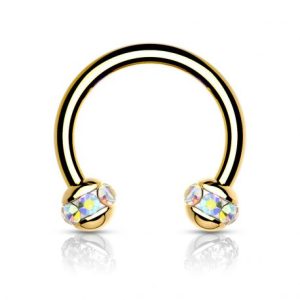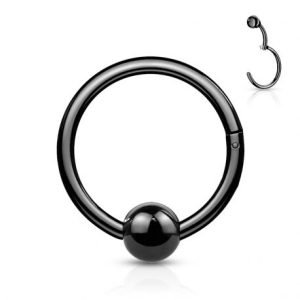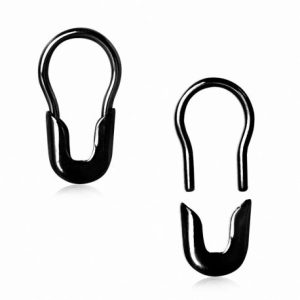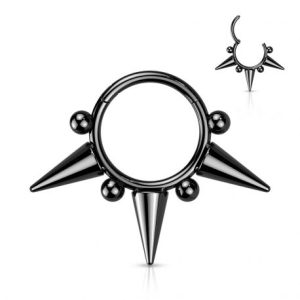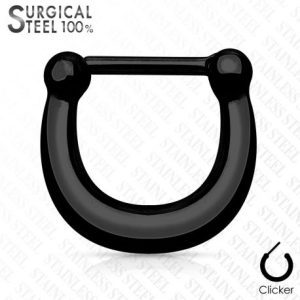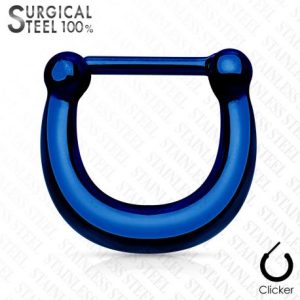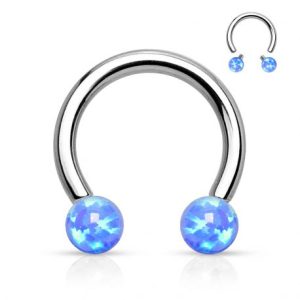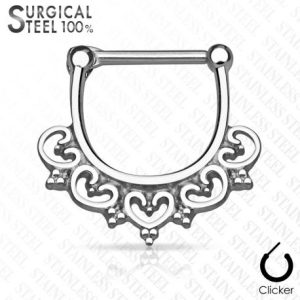Septum Piercing
Septum Piercing: Everything You Need to Know
Septum piercings, which involve inserting a piece of jewelry into the thin strip of cartilage between the nostrils, have been around for centuries and have been worn by different cultures throughout history. Despite their long history, they remain a unique and bold choice for nose piercings. With their recent resurgence in popularity, more and more people are sporting septum piercings as a way to express themselves and stand out in fashion. In this article, we’ll explore everything you need to know about septum piercings, including their history, the piercing process, post-piercing care, and potential risks.
What is a septum piercing?
A septum piercing is a type of nose piercing that is done through the thin strip of skin that separates the nostrils. The jewelry is inserted through the piercing and rests inside the nose, making it a discreet and versatile option for body modification.
Septum nose piercings have become increasingly popular in recent years, and can be customized with a wide variety of jewelry types, including captive bead rings, circular barbells, septum clickers, septum tusks and more.
| Type of Piercing | Angel Bite Piercing |
|---|---|
| Placement | The septum piercing involves inserting jewelry through the cartilage that separates the nostrils. |
| Cost | $40 – $100 |
| Pain Level | 7/10 |
| Healing Time | 4 – 6 months |
| Aftercare | Clean it twice daily with saline solution and avoid touching or applying soap or skincare products to the area to promote healing and prevent infection. |
How Are Septum Piercings Done?
Septum piercings are typically done in a professional piercing studio by a trained piercer. Here’s what you can expect during the procedure:
- The piercer will first clean the area around the septum with an antiseptic solution.
- They will then mark the location where the piercing will be made, using a surgical pen.
- Next, the piercer will use a hollow needle to create a hole through the septum. This can cause a brief but intense sensation of pain or discomfort.
- Once the needle has been inserted, the piercer will carefully slide the jewelry into place. Common types of jewelry used for septum piercings include circular barbells, captive bead rings, and septum clickers.
- Finally, the piercer will give you aftercare instructions, which typically include cleaning the piercing twice daily with saline solution and avoiding touching the piercing unnecessarily.
The entire process typically takes only a few minutes, but the healing process can take several months.
Do septum piercings hurt?
Septum piercings are generally considered to be more painful than other types of nose piercings, with a pain level typically rated around 7 out of 10. However, pain tolerance can vary greatly from person to person, and some individuals may find the piercing to be less painful than expected.
During the piercing process, the piercer will use a hollow needle to create a hole through the septum, which can cause a brief but intense sensation of pain or discomfort. After the piercing, some soreness, swelling, and tenderness is common, but this should subside within a few days.
How long does it take for a septum piercing to heal?
On average, it takes about 4 to 6 months for a septum piercing to fully heal. However, the healing process depends on several factors, including aftercare practices, how much the piercing is touched during the healing process, overall health, and any potential complications.
During the first few weeks after getting a septum piercing, it is common to experience some swelling, redness, and tenderness around the piercing site. This is a normal part of the healing process, and these symptoms should gradually subside within a week or two.
Following proper aftercare instructions is essential for promoting healing and preventing infection. This includes cleaning the piercing with saline solution twice a day, avoiding touching the piercing with dirty hands, and avoiding submerging the piercing in water, such as in swimming pools or hot tubs.
Touching the piercing excessively during the healing process can delay healing and increase the risk of infection. It is important to avoid playing with the jewelry or twisting it, as this can cause irritation and prolong the healing process.
Septum Piercing aftercare
After getting a septum piercing, proper aftercare is crucial to prevent infection and promote healing. This involves cleaning the area twice a day with a saline solution and avoiding touching the piercing with dirty hands. Additionally, it is important to modify your skincare routine during the healing process to avoid using soap or moisturizer in close proximity to the piercing, as this can introduce bacteria and prolong the healing process.
It is also recommended to avoid soaking in baths or hot tubs during this time. Once the piercing has fully healed, there is no need to worry about modifying your skincare routine since the piercing is on the inside of the nose and should not regularly come into contact with skincare products.
Proper aftercare for a septum piercing involves the following steps:
- Wash your hands thoroughly with soap and warm water before touching the piercing.
- Clean the piercing twice a day with a saline solution. You can either purchase a saline solution specifically for piercings or make your own by mixing 1/4 teaspoon of non-iodized salt with 8 ounces of warm water. Soak a cotton ball in the solution and apply it to the piercing for 5-10 minutes.
- Gently pat the area dry with a clean paper towel or allow it to air dry.
- Avoid touching the piercing unnecessarily, as this can introduce bacteria and prolong the healing process.
- Avoid submerging the piercing in water, such as swimming pools or hot tubs.
- Avoid wearing tight clothing or hats that may irritate the piercing.
- Keep soap and skincare products away from the immediate area to prevent irritation.
- Eat a healthy, balanced diet to promote healing.
Potential Risks and Complications
Side effects of septum piercing can include infection and irritation. It is important to monitor for symptoms such as pus, swelling, or increasing pain as they could indicate an infection. Seasonal allergies and colds may also increase the risk of infection and irritation, so it is recommended to avoid getting a septum piercing during those times.
Some people may experience a strange smell while wearing a septum ring, which could be a sign of infection or an irritation to a type of metal. Additionally, granulation tissue and scarring may form at the site of the piercing, which is an over-reaction of the healing process due to the environment of the nose and the jewelry.
While septum piercing is generally safe, there are possible risks and complications to keep in mind. These include:
- Infection
- Allergic reaction to jewelry
- Scarring
- Bloodborne diseases if non-sterile equipment is used
What types of jewelry are best for a septum piercing?
There are several types of jewelry that are suitable for septum piercings, each with its own unique style and advantages. When choosing jewelry for a septum piercing, it is important to consider the size and gauge of the piercing, personal style, and comfort level.
Here are some of the most popular types of jewelry for septum piercings:
- Captive Bead Rings: These rings are a classic choice for septum piercings and are made from a metal ring with a removable bead that closes the ring. Captive bead rings come in a variety of sizes and materials, making them a versatile option for all types of septum piercings.
- Circular Barbells: These are barbell-shaped jewelry that curves into a circular shape, making them a comfortable and stylish option for septum piercings. They are available in various materials such as gold, silver, and titanium, and can be customized with various beads and gems.
- Septum Clickers: These are a newer type of jewelry designed specifically for septum piercings. Septum clickers click into place and are held in by tension, creating a secure and comfortable fit. They come in a wide range of designs, from simple and elegant to bold and flashy.
- Septum Retainers: These are clear or flesh-colored jewelry pieces that are designed to be subtle and hide the piercing. They are ideal for conservative or professional settings where body modification may not be allowed.
- Septum Tusks: These are a unique and bold type of jewelry that can make a statement. They come in various shapes, sizes, and materials, such as bone, wood, and metal, making them a versatile choice for those who want to express their individuality.
How much does a septum piercing cost?
Septum piercing costs can vary depending on a few factors, including the experience of the piercer, the location of the studio, and the type of jewelry used.
On average, the price of a septum piercing falls between $40 and $100, but prices can range higher or lower depending on these factors. It is important to research and compare prices between different piercing studios to ensure that you are getting a fair price for your piercing.
The experience and reputation of the piercer can impact the cost of the piercing, as more experienced piercers may charge higher prices for their services. Additionally, the location of the studio can also affect the cost of the piercing, as studios in more expensive cities or neighborhoods may charge higher prices.
It is important to confirm whether the cost of the jewelry is included in the price of the piercing, as some studios may charge additional fees for the jewelry used. The cost of the jewelry can also impact the overall price of the piercing, as more expensive or customized jewelry may be more costly.
How do I change my septum piercing?
If you’re interested in changing the jewelry in your septum piercing, it’s important to wait until the piercing has fully healed before attempting to do so. Here’s how you can safely change your septum piercing:
- Clean your hands and the new jewelry with an antibacterial soap.
- Soak the piercing in warm water or use a warm compress to help loosen any crust or debris around the jewelry.
- Gently twist and pull the jewelry out of the piercing, being careful not to force it if it feels stuck.
- Quickly and carefully insert the new jewelry into the piercing. If it doesn’t easily slide in, do not force it – this can cause damage to the piercing.
- Once the new jewelry is in place, clean the area with saline solution and avoid touching it unnecessarily.
How to Hide a Septum Piercing?
To hide a septum piercing, you can flip the jewelry up into your nose so it is not visible. Alternatively, you can wear a retainer or a smaller piece of jewelry that is less noticeable. It’s important to note that hiding the piercing for extended periods of time may interfere with the healing process, so it’s best to only do so temporarily.
FAQs
How long does it take for a septum piercing to heal?
Septum piercing can take anywhere from 4 to 6 months to heal completely.
Does septum piercing hurt?
Yes, septum piercing is painful like many other nose piercing.
Can I change the jewelry in my septum piercing?
It’s recommended that you wait until the piercing has fully healed before changing the jewelry. This can take several weeks.
Can I hide my septum piercing for work or other occasions?
Yes, there are retainers available that can make your septum piercing less noticeable.

